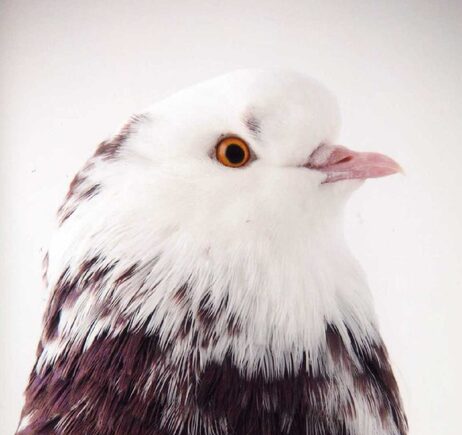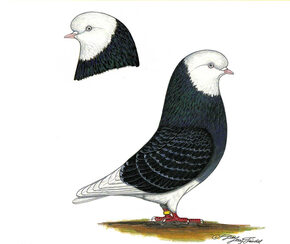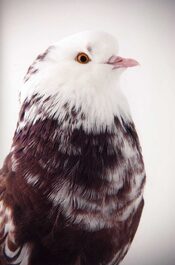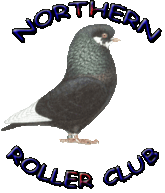Harislau : Utility Poultry & Fancy Pigeons
John S Harrison

The Show Roller
The Birmingham Roller was originally bred in the 'Black Country', and over a period of more than a century was developed into the world's finest performing aerial acrobat; however within the past thirty years there has been a tremendous divergence in type between the 'Flying' Roller' bred for free flight and competitive flying, and the 'Show' Roller bred purely for the showpen – though ironically there are classes for both at the shows! They are as different as chalk and cheese!
The original Birmingham Rollers were selected for performance alone with no regard for head shape, beak setting or feather. Quite surprisingly, they are of very consistent appearance, but the rolling ability does vary considerably, today the Birmingham Rollers bred for flying are generally referred to as 'Flying' or 'Competition' Rollers. The 'Fliers' are very small dainty little birds with a very bright eye and a very alert cheeky manner; they have short close fitting feathering. Generally they have a small neat head and a small well-muscled 'apple' shaped body which fits the hand so nicely. They stand on their toes always looking alert and eager, usually with clean legs, but occasionally with 'grouse' legs or 'stockings'.

Tortoiseshell Show Roller Hen
Owned by John S Harrison
Photo : Richard Bailey
The 'Show' or 'Exhibition' Roller which has been developed over the past thirty years is very different to the Competition / Flying Roller from which it was developed. It is an alert looking bird with a short wedge shaped body carried on short legs, which are generally clean legged but occasionally grouse legged birds are seen. The wings rest on the tail and the angular stance results in the tip of the tail sloping to the ground but not resting on it. It is essentially a head breed, it has a fine spindle beak which is set straight off the face. Eyes are bright and generally orange to yellow in colour. The head has a prominent frontal and a strong back skull giving a distinctive shape to the breed and flows into the very dense neck feathering. A fundamental requirement is that the breed must have dense high quality feathering which is silky to the touch. It used to be a balanced bird of flying type; today however, the head shape and feathering is considered to be of prime importance by breeders and judges. .
The Show Roller does have a written Breed Standard which is currently awaiting EE approval. Devotees of the 'Flying breeds' are generally still divided over the need for a written standard, however to protect the breed a standard had to be lodged with the EE to ensure the breed as we know it is preserved.
There are no set markings or colours in this breed, all colours and patterns are acceptable with or without white markings, and this factor adds to the appeal of the breed. The majority of Show Rollers have white wing flights and white tails but self-colours are seen. By and large colour is not considered to be important other than for separating into classes at shows but of course there are numerous breeders who are fascinated by colour. I have a particular liking for highly burnished Bronze in all its patterns and variations; richly coloured Recessive Red and the dilute Yellow; and richly coloured Tortoiseshell.
Ironically in a breed where colour is deemed of little importance there are numerous descriptive names such as 'bald', badge','beard', 'saddle', 'rosewing', 'oddside' which have traditionally been used to describe the various markingsof Birmingham Rollers, and continues today in the Show Roller. My aim is to eliminate 'bald' markings and 'bibs' from my birds, in preference for 'badges' and 'beards' with and self.
The main club for Show Rollers is the Northern Roller Club which was formed in 1967 and though it has a strong 'northern' base has members from all over the UK, at the present time there is classified as a regional club by the NPA rather than a breed club. The club issues size A rings (identified by the letters NRC) for Rollers, and holds a Championship Show in Bradford early each January, plus a late summer show in Cumbria. For devotees of the Roller these shows really are a 'must'.
My Birds
My introduction to the Birmingham Roller was as a small boy when I was given a pair of Black & White Rollers: several years later, when I was 14, I bought two pairs of Red 'Rosewings' originating from stock bred by William Pensom. I then diversified into various Fancy breeds, but still kept the Rollers.
After a break of some years when it was not possible to keep pigeons, I had a 'cloud' of non-descript flying tumblers in the garden: I had no intention of returning to breeding for exhibition!
In 2000 I returned home from a 'casual' visit to a pigeon show in Doncaster with a pair of Show Rollers; this led to obtaining further birds from top breeders Trevor Mason and Jeff Davies. In 2009 Jo Taylor decide to part with her stud of Show Rollers and gave me the basis of her richly coloured Bronze, Red Spangle, and Tortoiseshell family – a wonderful gift indeed for which I will always be indebted. Jo’s birds were based almost entirely on Terry Broad’s outstanding strain. To improve various features, and to reduce the amount of white in my birds I have added further excellent quality birds again from Jeff Davies who was awarded a 'Master Breeder Certificate' in 2011 in recognition of his breeding achievements.
Whilst Show Rollers are available in a multitude of colours and markings (none of which have any importance in the showpen!) I am only interested in breeding Bronze, Recessive Red (plus hopefully Yellow!) and Tortoiseshell, and concentrate on breeding heavily coloured Badges and a few Selfs. My personal preference for my own birds is for limited white markings; though in selecting breeding birds type must take precedence, and when judging colour and markings are totally unimportant!
The Show Roller Breed Standard
The Show Roller
Origin:
Over a period of 45 years, dedicated NRC members drawn from all parts of the UK have transformed a utility dual purpose flying Roller into today’s unique Show Roller. The ‘show standard’ as agreed by the active NRC members in 2002, is set out to maintain a pigeon of size, body type, shape and plumage, suitable for kit flying – in fact a show pigeon which can fly with style and endurance. It has been over the past 25 years that the Show Roller has become a standardised show bird. This is manifestly evident when Show Rollers are viewed though the wires at any NPA Championship Show. Type is paramount – the head and neck qualities are unique amongst pigeon breeds. Uniformity of type is quite evident when a class of Show Rollers is viewed.
Overall Impression:
A small to medium sized pigeon with balance and symmetry, short and wedgy in shape, giving the impression of “designed for flight”.
Recognised colours:
Blacks, Blues, Reds in Ash and Recessive, Browns; the dilutes of these basic colours and with most of the autosomal modifiers, dominant Opal, toy stencil, indigo, and particularly Grizzle and Bronze. These two influences play a very significant role in all strains of Show Rollers (for example Tortoiseshell and Bronzed Blues).
Markings:
Chequers, Bars, Self Colours and Tortoiseshells in every shade from the darkest to almost White. Bals heads, Badges, Beards, Saddles, Oddsides, White flights, Dark flights, White tails, Dark Tails and mixed colours in both flights and tails. Although fanciers do have personal preferences, the overall dictum of outr members is “good type” is of far more importance than colour or markings.
Limbs:
Short legs, wings that are carried on the tail and wing butts should blend well with the body.
Body:
A firm apple body is required, with keel of medium depth, sweeping up to meet the vent bones. The flesh and muscle gives the body the ideal feel.
Eyes:
Should be bright with pinhead sized pupils (in good light conditions). Eye colour varies from pearl to deepest orange – orange or yellow without blemish are preferred. Bull eyes are a disqualification in the showpen. The eye cere should be hardly visible.
Eye Faults – Large pupils or pupils that appear off centre. Eyes that are blemished or stained should be faulted.
Beak :
A fine spindle beak is of vital importance. It should be medium length and set square off the bird’s face. Clean flesh-coloured beaks are preferred on Bald head or Badges. Dark headed birds with dark coloured or stained beaks are the norm and perfectly acceptable.
Beak Faults – A thick or coarse beak is a bad fault, as are beaks angled down from the face (ie down-faced). Again this is regarded as a serious fault.
Wattles :
These beak appendages should be small, neat and white in colour.
Wattle Faults – Large coarse wattles, or any sign of discharge from the wattles.
Skull and its plumage :
The Show Roller frontal is vital to its expression. Ideally it is nipped in behind the wattle from where it rises in a slightly widening arc to its zenith above, but just in front of, the eyes. The frontal plumage also arcs out in a slightly smaller radius into the birds face. From above the eye the contours of the head plumage should fall slowly in a sweeping arc into a strong back skull that blends into the thick dense neck plumage. The neck itself should be short and blend into the body above the wing butts. Cock birds should exude masculinity while hen birds should show their femininity.
Faults – Snipey, narrow frontals are to be avoided. But conversely, so is over-wide frontal plumage which obstructs the bird’s frontal vision. The whole head should please the beholder and be free of any corners. Round heads like golf balls are regarded as a serious weakness.
Plumage :
The body plumage should have a rich silky texture and be as dense as possible. Back cover should be likewise dense and should extent onto the middle of the tail, providing a waterproof rump. A spread open wing should have strongly sprung primary and secondary flights, with no gaps. The 12 tail feathers should be similarly endowed. When closed the tail should be no more than 35mm wide.
Feather Faults – Frets in flights, tail or body plumage must be faulted. Missing flights, secondaries or tail feathers incur a penalty, as do pinholes. Feather lice or mites must also be faulted.
Station :
At best, a Show Roller should be low on the legs, with legs nicely spaced. The wings should be carried on the tail and the short tail angled down and carried about 25mm above the floor. The head should be carried some 70mm in front of the axis on a short thick neck, giving an impression of alertness, and designed for flight.
Faults – Long cast birds with long tails are a major fault, as are wings not carried correctly on the tail (ie wings which constantly droop below the bird’s tail).
Judging to a points system :
A class of Show Rollers should be assessed by the judge initially through the wires. In this way the bird’s overall qualities are ascertained and faults in type are easily seen. After initial inspection each bird should be handled, giving each half a minute to settle in the hand before the critical assessment begins. Body type and condition are the first points the judge will assess, followed by feather quality and cleanliness. After this, the all-important head qualities are examined in great detail and given an appropriate score. At this stage in the judging, it is most important that the pigeon in the hand is as relaxed as possible. In a relaxed state state the bird will show it’s best or, conversely, its worst qualities. In Show Rollers, head and neck qualities amass 50% of the total points.
Points:
Beak 10
Frontal 8
Back skull 8
Face 8
Eyes 8
Neck 8
Body 10
Feather 10
Overall type 12
Condition & cleanliness 10
Colour & Markings 8
Group : Tumblers
Ring Size : A (7mm)
Standard first published in 2002 by the NRC
Revised 2012
 © John S Harrison
© John S Harrison

The Basic Facts
Origin:
Great Britain 20th Century
Developed from performing Birmingham Rollers
Ring Size:
7mm - NPA size A
Can be ringed with NRC rings
Top awards 2012
British Pigeon Show Society / NPA National Show
1 & 2 December 2012
2012 Tortoiseshell Hen
Third Place in Flying Section
for the Tattershall Trophy


